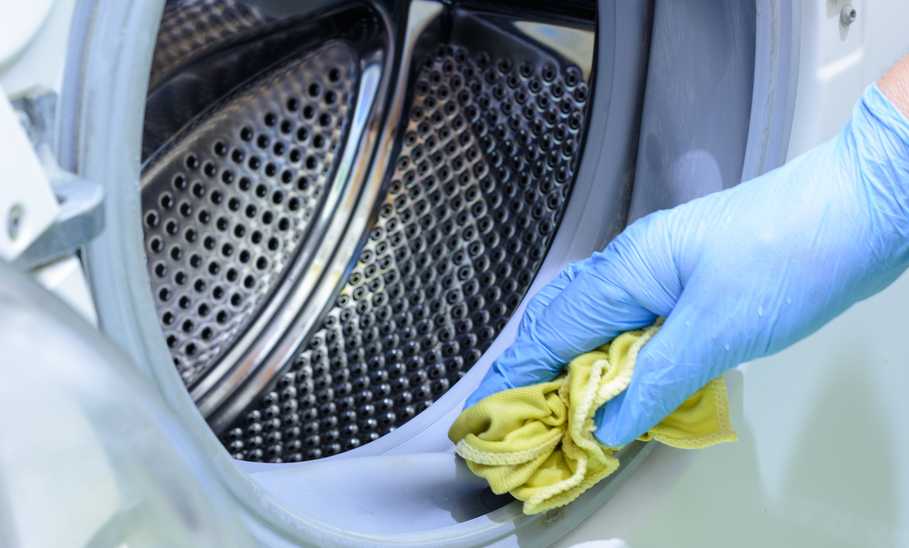How to Clean a Washing Machine

Our evaluations and opinions are not influenced by our advertising relationships, but we may earn a commission from our partners’ links. This content is created by TIME Stamped, under TIME’s direction and produced in accordance with TIME’s editorial guidelines and overseen by TIME’s editorial staff. Learn more about it.
Like many of us, I’ve washed a lot of laundry over the years. I’ve done my own at home, and I’ve worked in costumes and wardrobe for film, television and theater for over 30 years where it’s not uncommon to do multiple loads daily. What many don’t realize is that, to keep your machine running well and your clothes smelling fresh (and free from residue) you need to occasionally clean the machine itself.
I learned this long ago in the basement of the Alley Theatre in Houston, Texas from someone older and wiser after an actor repeatedly complained that his t-shirt smelled moldy despite the fact that I had, indeed, washed it. I’ve been routinely cleaning my washing machine—and the washers in costume shops nationwide—ever since.
I consulted some industry experts to put together the most detailed and informative approach to cleaning your washing machine, whether it be a front-loading or top-loading one. I also considered whether you’re doing laundry for yourself and your family—or the entire cast of Tony Kushner’s “Angels in America.”
Laundry Basket LLC owner and CEO Hyacinth Tucker suggests creating a regular cleaning schedule to prevent the buildup of dirt, soap scum, and mold. “Aim to clean it at least once a month,” she says, “or more often, if you notice any residue or odors.”
Michael Rubino, a mold and air quality expert, environmental wellness advocate, and founder of HomeCleanse, also recommends monthly cleanings. This advice is especially applicable to front-loading machines.
“Cleaning frequency can depend on type and usage,” explains Marla Mock, President of Molly Maid, a Neighborly company. “Typically, top-loading machines require a thorough scrubbing twice a year, while front-loading machines should be cleaned monthly to prevent mold growth.”
“Regular cleaning helps remove soap scum, dirt, or other residues that accumulate in the machine,” says Rubino, in addition to microscopic particles like mold spores and bacteria—two things you don’t want growing in your home. As most of us know, damp, dark environments, such as the interior of your washing machine, create an optimal breeding ground for mold, mildew, and bacteria. “Cleaning also helps with the longevity of your machine and ensures it works properly,” adds Rubino.
A variety of signs indicate it may be time to clean your washing machine, says Mock. The most obvious include foul odors, residue on clothing, and/or visible mold or mildew—as well stains or discoloration inside the drum or on any rubber seals. If your machine drains slowly or emits increased noises or vibrations, these may also mean it’s time for a good cleaning. “Monitoring all these signs helps maintain the machine's performance and hygiene,” says Mock.
Use an all-purpose cleaner and a microfiber cloth to clean the outside of your machine, suggests Mock. Some examples include Lysol’s All Purpose Cleaner and my favorite, Seventh Generation Unscented All Purpose Cleaner.
For the interior, Mock recommends white vinegar, a toothbrush, and a stiff nylon brush.
“These are useful for scrubbing hard-to-reach areas and removing mold,” she explains.
To disinfect, use a chlorine bleach. A soft bristled brush works well for scrubbing filters and dispensers. Rubino recommends using microfiber towels as they’re better for wiping away small particles.
The experts I spoke to outlined the following steps for cleaning a washing machine:
Remove control knobs if possible and wash them in the sink. Then, wipe down the exterior with your microfiber cloth and all-purpose cleaner. If you can, move the machine to vacuum behind it, inspecting the rubber water supply hoses for any damage in the process.
Extract any removable parts, such as the soap tray, and clean them separately. Using a cloth, toothbrush, and white vinegar, scrub the crevices inside the machine, including the lid, rubber gasket, and any other part you can reach. Mock says to pay special attention to smaller parts and any traps for debris.
To clean the interior drum, pour a quart of white vinegar and a cup of baking soda into the wash drum. Then scrub with a stiff nylon brush. Allow everything to sit for an hour. Wipe down with a microfiber cloth.
Locate, remove, and clean the washing machine filter. This will either be in the center agitator, the drum top lip, or behind a trap door, says Mock. Soak the filter in hot water and laundry detergent. If necessary, gently scrub with a toothbrush.
On the hottest setting and at the highest fill level, run a cycle with two cups of white vinegar. If your machine has a sanitizing or self-clean cycle, use that.
Empty the washer and dispenser drawers. Run a cycle with warm or hot water and a cup of chlorine bleach. Dry around the gaskets and door afterward. Clean the dispenser system and filter with a soft-bristled brush.
Run one more cycle with hot water through the machine to ensure all residue and particles are gone. Place EC3 Laundry Additive into the detergent tray for another layer of sanitation.
Front-loading washing machines are slightly more complicated to clean than top-loading ones, says Elizabeth Shields, operations manager of Super Cleaning Service Louisville, a professional cleaning company. “You need to clean the rubber gasket around the door too,” she says, “this area collects mold and mildew, which can be a pain to deal with.” Give it a thorough cleaning with a mild detergent and scrub brush if necessary. Afterward, run an empty load with hot water and white vinegar to ensure everything is clean.
Mock goes a few steps further and suggests adding a half cup of chlorine bleach to the detergent compartment and running a full cycle weekly. Afterward, she says, wipe down the surfaces and clean inside gaskets to prevent mold growth.
Top-loading washing machines are fairly straightforward to clean, says Shields. As outlined above, after unplugging, wipe down the drum, detergent dispenser, and agitator. Then, run an empty load with hot water and white vinegar to remove any leftover grime and unwanted smells.
For an even deeper clean, choose the hottest and longest cycle, says Mock. “Fill the washer with water, but pause before the agitator starts. Add four cups of chlorine bleach and resume the cycle.”
Use vinegar to clean dispensers. After, refill with hot water, add four cups of vinegar, and finish the spin and wash cycle. Finally, wipe down the exterior to finish.
To prevent mold, keep the washing machine door and soap drawer open after use until the inside dries, Shields suggests. And, run a cycle with cleaning tablets at least once a month.
She also recommends making it a habit to wipe the gasket dry with a clean cloth after every use. The gasket is the rubber seal around the door that prevents water from flowing out of a front-loading washing machine. If you can afford it, purchase an oscillating fan and position it in front of the open washing machine to aid in the drying process.
Front-loading machines, as well as washer/dryer combination ones, will have a small door on the front that houses your drain pump filter. Open this door and remove the filter periodically to clean—it will likely screw out. On my washer/dryer combo unit, when I unscrew the filter, water flows out. This is normal. Be sure to have towels on hand to catch the water. Remove any lint or, as is usual in my case, trapped safety pins, from the filter then reinsert.
Rubino recommends using a botanical laundry additive with every wash. “This helps remove particles like spores from the washing machine and clothing,” he says. He also suggests keeping indoor humidity between 35 and 50% to help keep the machine dry and prevent microbial growth. And never allow wet clothes to languish in your washer.
“A mold spore can grow in 24 hours on a surface with moisture and organic material like soap scum,” he warns.
Mock suggests cleaning the filter and debris trap weekly and using time-released tablets to keep it fresh between deep cleanings. Always follow detergent guidelines, especially for high efficiency machines, to prevent buildup. For front-loading machines, keep the door cracked open when not in use to avoid mold growth.
If you consider to buy a new washing machine our team of experts recommend to buy:

Both work well. Bleach is more effective for removing mold and mildew while vinegar excels at combating odors. Vinegar is also more environmentally friendly and affordable. Remember to never mix the two, as that results in the release of toxic chlorine gas.
“If your washing machine develops a noticeable odor, clean it,” says Rubino, “especially if it smells earthy, cigar-like, and/or musty.” This odor often indicates the release of gasses from fungal or bacterial growth called microbial volatile organic compounds (MVOC). These sorts of compounds can cause eye irritation and negatively affect your respiratory system.
To clean mold out of a washing machine follow the steps outlined above using vinegar, then bleach — but not at the same time, as mentioned.
As mentioned above, white vinegar and bleach excel at removing mold and bacteria—again, just be sure never to mix the two. Use a botanical cleaning product such as Benefect Decon 30 on the exterior if you prefer something more natural.
The information presented here is created by TIME Stamped and overseen by TIME editorial staff. To learn more, see our About Us page.



